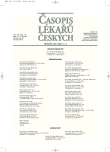The Polycystic Ovary Syndrome and Its Male Equivalent
Syndrom polycystických ovarií a jeho mužský ekvivalent
Východisko.
Syndrom polycystických ovarií je multifaktoriální onemocnění, na jehož rozvoji se podílí jak genetické vlivy, tak vlivy zevního prostředí. Genetický podklad syndromu polycystických ovarií s autozomálním přenosem vedl k myšlence výskytu tohoto syndromu i u mužů, pochopitelně s jinou expresí příznaků. Předčasná androgenní alopecie byla uvažována jako jeden z možných příznaků mužského ekvivalentu syndromu polycystických ovarií.
Metody a výsledky.
Byla sledována skupina 30 mužů s předčasným výpadem vlasů před 30. rokem, u nichž bylo vyšetřeno hormonální spektrum a proveden inzulínový toleranční test. Robustní Mannův–Whitneyův test a Fisherův test byly použity pro statistickou analýzu. Podle hormonálních hladin bylo možné vytvořit dvě skupiny. První měla obdobné hormonální změny jako ženy se syndromem polycystických ovarií, a to nízkou hladinu SHBG, vysoký index volného testosteronu a nižší folikulostimulační hormon (FSH). Druhá skupina byla bez hormonálních změn nebo bylo pouze nižší SHBG. V obou skupinách nebyl rozdíl ve věku ani v body mass indexu. Probandi ze skupiny s hormonálními změnami jako u syndromu polycystických ovarií měli statisticky významně vyšší sklon k inzulínové rezistenci.
Závěry.
Muži s předčasným výpadem vlasů a hormonálními změnami podobnými jako u žen se syndromem polycystických ovarií by mohli představovat mužský ekvivalent syndromu polycystických ovarií. Odpověď na otázku, zda existuje mužský ekvivalent syndromu polycystických ovarií, bude však možno dát teprve tehdy, až bude známa molekulárně genetická charakteristika syndromu u žen.
Klíčová slova:
syndrom polycystických ovarií, mužský fenotyp syndromu polycystických ovarií, androgenní alopecie, folikulostimulační hormon, sex hormon binding globulin (SHBG), metabolický syndrom, inzulínová rezistence.
Authors:
M. Dušková; M. Hill; L. Stárka
Authors‘ workplace:
Endokrinologický ústav, Praha
Published in:
Čas. Lék. čes. 2007; 146: 251-255
Category:
Original Article
Overview
Background.
The polycystic ovary syndrome is multifactorial disease. The autosomal genetic transfer of the disease predisposition is the basis for hypothesis that there can exist a male equivalent of PCOS. Androgenetic alopecia has been suggested as the symptom of the male phenotype of PCOS.
Methods and Results.
A group of 30 men with premature hair loss was involved in the present study. In all individuals, their hormonal profile was determined and insulin tolerance test was made. Robust Mann-Whitney test and Fisher’s exact test were used for statistic analysis. Based on the laboratory findings two subgroups of individuals were shown. The first one revealed similar hormonal changes as women with PCOS, namely lower SHBG, lower FSH and elevated free androgen index. The other had either no anomaly in steroid spectrum. Both subgroups did not differ in either BMI or age. The subgroup with hormonal changes resembling those of PCOS, showed a significantly higher insulin resistance than the group without these changes.
Conclusions.
Based on our results it can be concluded that men with premature alopecia and hormonal changes partially resembling those typical for female PCOS, might probably represent the male equivalent of PCOS.
Key words:
polycystic ovary syndrome, male phenotype of PCOS, androgenetic alopecia, FSH, SHBG, insulin resistance.
Labels
Addictology Allergology and clinical immunology Angiology Audiology Clinical biochemistry Dermatology & STDs Paediatric gastroenterology Paediatric surgery Paediatric cardiology Paediatric neurology Paediatric ENT Paediatric psychiatry Paediatric rheumatology Diabetology Pharmacy Vascular surgery Pain management Dental HygienistArticle was published in
Journal of Czech Physicians

- What Effect Can Be Expected from Limosilactobacillus reuteri in Mucositis and Peri-Implantitis?
- Spasmolytic Effect of Metamizole
- Metamizole at a Glance and in Practice – Effective Non-Opioid Analgesic for All Ages
- Advances in the Treatment of Myasthenia Gravis on the Horizon
- Metamizole vs. Tramadol in Postoperative Analgesia
Most read in this issue
- Neurosteroids and Their Function
- Relationships Between the „Eating Inventory“ Factors, Socioeconomic Status, Anthropometric Body Adiposity Indexes and Health Risks in Czech Population
- Obesity Based on Mutation of Genes Involved in Energy Balance
- Growth Hormone Treatment in the Institute of Endocrinology
